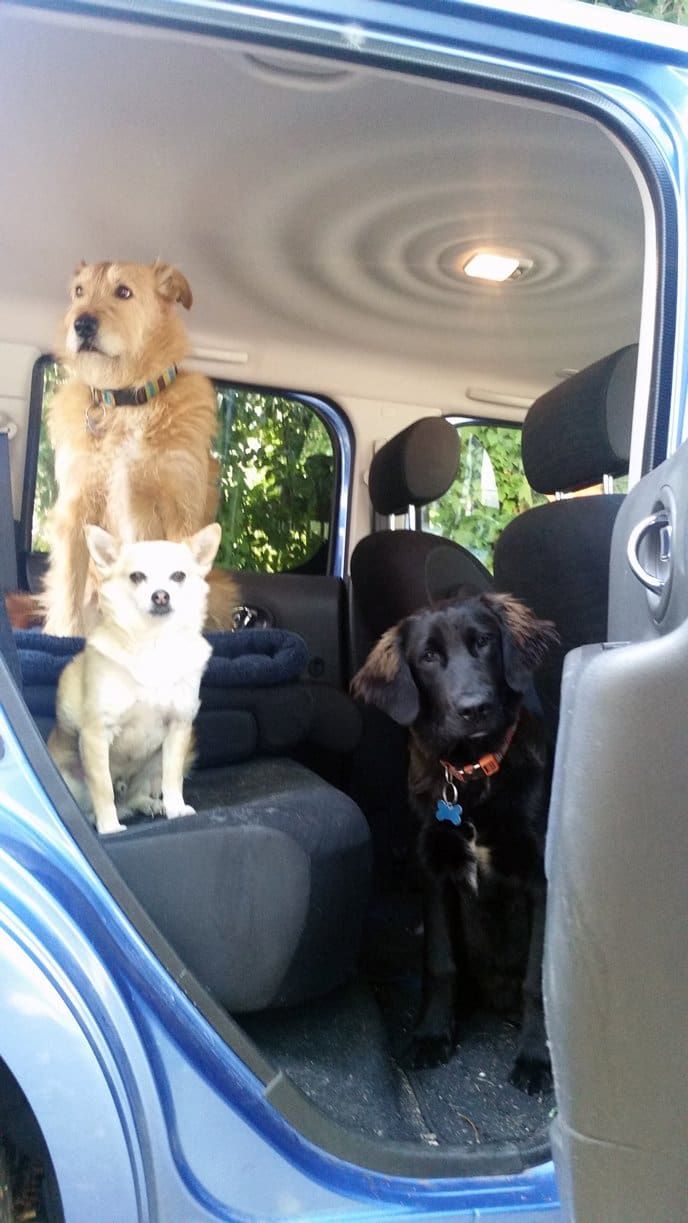A short blog post today, to remind myself (and perhaps others) of something so simple I forget it all the time: When a dog is having trouble learning something, “pose the question” differently!
Case in point: I’m fostering a puppy, about six months old and about 40 pounds. When I brought him home from my local shelter, he was terrified of the car. A week later, he’s now much more comfortable in the car, but (until yesterday) he was still reluctant to approach it, even when being lured with treats and toys.
My office is in a house that’s three blocks from where I live, and I rent other rooms in the house to students. I drive my car back and forth in that three-block “commute” several times a day – ridiculous, I know, but when I’m toting my laptop and/or camera, my own two dogs and a foster dog or two, and a sandwich or coffee, it’s often easier to pile everything into my car and drive. (When I have time and nothing to carry, the dogs and I all walk from one house to the other, of course.)
My car is a hatchback, and there is ample space behind the seats for my dogs on this short drive. But the back bumper of the car is sort of high, and while I’m certain the puppy is capable of jumping into the back of the car (given that tiny Tito can do it), he is too daunted to even try. So, I have been lifting him up and place him in the car.
After five or six days of this commute, my current foster puppy learned that his fun quotient will drastically increase when the short car ride is over; all the dogs jump into the car, and about a minute later, we all get out and do something else. He will now approach the car with interest, but he absolutely wants nothing to do with hopping into the “way back” of the car with the other dogs, even when I’m waving his favorite treats or toys under his nose.
I was discussing this with a friend who has volunteered to foster him next, in the context of “he’s doing so great, but we have a thing or two to work on,” when she mentioned that she will have to get a ramp ready; she had back surgery not long ago and can’t lift a dog of his size yet. Shoot!, I thought, anticipating that it might be a challenge to teach him to walk up a ramp, too. And then it struck me: Why don’t I see if he would be more willing to get into the car from one of the side doors? The floor of the back seat is quite low, and perhaps he’d approach that spot more willingly.
It took ONE luring session to convince him that the floor of the back seat was a nice, safe space for him to jump up into and ride in. Now the whole troop, puppy included, runs to the car, and when I open the back hatch AND the side door, everyone jumps in on their own. Problem solved.
But why didn’t I think of that days ago? Because I was “set” on the way I usually do things: opening only the hatch, and having all the dogs jump in the way back. I wasn’t thinking like a dog trainer ¬- excusable, maybe, since I’m NOT a dog trainer, just an editor who writes about dog training. But after this much time of writing about dog training, seriously? Five days of not thinking outside the box with this puppy? Continuing to do something that wasn’t working all that well? It was only when my friend mentioned her specific needs for the puppy that I considered trying something different, and that something worked immediately. And why wouldn’t it? He’s a bright puppy! He’s learning all sorts of other skills daily.
Anyone who has ever studied a foreign language – or even higher math – knows that when you don’t understand a concept or phrase, it’s no good having the instructor repeat that concept or phrase over and over again. If you don’t get it, having the instructor repeat it verbatim (and perhaps louder) is unlikely to help you understand. But if the instructor puts the question a different way, shows you an alternate solution to the problem, uses a slightly different phrase to explain the concept, AH, RIGHT! Often the light bulb goes on in your head.
Dogs are no different; they can’t all learn everything in exactly the same way. As your dog’s “instructor,” be creative, and don’t “teach by rote.” If your otherwise smart (or at least willing) dog is stuck on some concept, look for a new way to teach it to him. Ask a dog-savvy friend or friendly trainer for ideas on an alternate approach. Just put the “question” to your dog differently, and see if the light bulb goes on.







